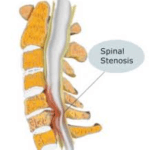Spinal stenosis- Can chiropractic help?
Spinal stenosis is becoming extremely popular diagnosis. An estimated 65 million people will be affected over the next decade. This is a very common diagnosis. Many patients in orthotopic and chiropractic offices may have it . I would like to review how people make diagnosis of spinal stenosis. There are many treatment options. Back pain is not enough of a symptom to warrant spinal stenosis. Symptomatic lumbar spinal stenosis must involve the legs. Leg pains is usually much greater pain than the back. A recent study showed that 80% of people diagnosed with spinal stenosis had pain with walking. They also had relief with sitting, and bending. The severity of the symptoms and a MRI findings usually do not correlate.
Symptomatic patients need to know certain things. There is little to no relationship with an MRI and severity of their symptoms. There has been no correlation to the amount of stenosis and the amount of pain present. A recent study of a 150 patients showed that the degree of stenosis on the MRI did not correlate to the severity of symptoms or the need of lumbar surgery. A bigger study of almost 1000 patients with MRI confirmed stenosis showed that only 17% had severe symptoms. The relationship between symptoms and imaging like MRI is not the entire diagnosis and therefore does not predict the appropriate treatment. The history of lumbar stenosis is generally favorable. Patients can be informed that there is no urgent need for surgery. Mild to moderate symptoms only occur in about a third of the patients. A recent study also showed that over a 5 year period, 70% of all people with stenosis remained stable, 15% improved, and 15% deteriorate without any surgical intervention. There are definitely options for patients. Most authorities recommend conservative care before surgery. A recent study showed no clear benefits from surgery compared to non-surgical treatment. Studies have shown how commonly patients choose inappropriate clinic pathways. These are based on seeing only one surgeon. Sometimes patients do not get multiple opinions. Patients need to know realistically what can be expected out of their care. Success rate depends on multiple reasons, such as their overall health. Weight, exercise, diet, and nutrition also play a role. Conservative care such as chiropractic, physical therapy, massage, should always be considered first. Drug intervention is second. Injections can be third. Surgery as the final option. Spinal stenosis diagnosis is not a tall tale diagnosis that will inform you that you need to have surgery. It is generally a complicated factor that needs to be looked at to determine if any other options are available.
Spinal stenosis has many causes. These causes can be thickened ligaments along the spinal canal. They can be from bony spurs. Enlarged joints can cause it. Enlarged cartilage can be from arthritic changes. Arthritic changes can be from trauma or overuse. Decreased blood flow to the spine can also result in spinal stenosis.
When stenosis occurs, structures can place pressure upon lumbar nerve roots. This pressure typically occurs when you are walking, and is relieved whe
